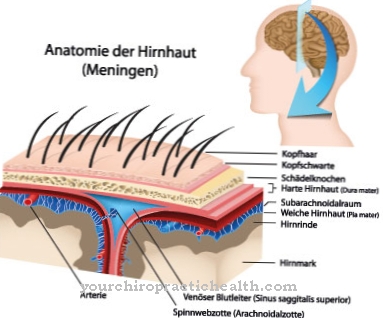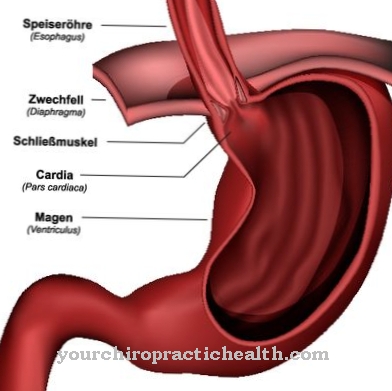Thromboses are not only a particularly painful affair, they can also severely affect the health of those affected. But that is not the only dangerous thing Venous thrombosis in itself, it also carries the risk of pulmonary embolism, which can be fatal without prompt treatment.
What is vein thrombosis?
A thrombosis is a vascular disease which can be fatal due to possible subsequent complications. A thrombosis usually occurs in veins, i.e. the veins that lead to the heart.
Arteries that carry blood away from the heart are rarely affected. In general, however, thrombosis can occur in all vessels. However, deep leg veins are particularly at risk.
The affected person's blood clumps and an unhindered blood flow is no longer possible. Instead, the lumps can be carried on by the bloodstream, where they often clog the pulmonary vessels and seriously threaten the life of the person affected.
causes
The formation of a trickle of blood, the so-called thrombus, has various causes. Damage to the vessel wall as well as slowed blood flow or an increased risk of the formation of lumps due to an altered blood composition are listed particularly frequently.
A lack of exercise, obesity, tobacco consumption, low fluid intake and injuries, as well as being bedridden and certain medications can also promote the development of vein thrombosis.
Symptoms, ailments & signs
Thrombosis can occur in any region of the body. Depending on the situation, the symptoms remain very mild or cause life-threatening complications. In many cases, tiny clots do not cause serious discomfort. However, if characteristic features are found, extreme caution is required.
Unusual feelings of tension in the limbs, some of which are painful, are typical. Slight swellings on the extremities and protrusion of superficial veins due to the backflow of blood can also be observed. There is a pronounced feeling of warmth in the affected area. A clear difference to other regions can be perceived by those affected by the laying on of hands.
Due to a lack of oxygen, the surrounding skin areas are discolored. Reddish or blue areas with a shiny surface are considered serious warning signs of venous thrombosis. Pressure pain on the inside of the foot, also Payr's sign as well as calf pain when bending the foot (Homans sign) indicate a vein occlusion of the leg.
Blood clots do not always express themselves to such an extent. Therefore, the absence of these symptoms should not be regarded as an exclusion criterion. An urgent emergency arises when there is rapid shortness of breath with accompanying chest pain. There may be a pulmonary embolism. The result is strong palpitations and dizziness or even fainting. The enormous stress increases the chance of heart failure. But thromboses are extremely dangerous in other areas too. Immediate notification of the emergency doctor remains inevitable under such circumstances.
Diagnosis & course
Thromboses are based on the development of blood clotting. Blood clotting is a natural process that the body uses to try to protect it. To avoid bleeding after injuries, the body ensures that the blood coagulates.
This clumps and closes the wound. In the case of a thrombosis, there is no wound that needs to be treated, but blood clots nonetheless without injuring a blood vessel. The clots that form prevent the blood flow from flowing smoothly and there is a risk of pulmonary embolism. During a thrombosis there is usually damage to the vascular wall, which occurs due to the accumulation of blood fat, calcium and connective tissue.
These settle on the vessel wall and form a natural barrier within the vein. If the deposit, called plaque, breaks open, the body reacts with a clotting reaction and the vessel is closed. In arterial thrombosis, this process leads to a heart attack. In the case of venous thrombosis, the plaque may be carried on by the blood and block other vessels during the course.
When should you go to the doctor?
Treatment by a doctor must always be provided for venous thrombosis. As a rule, this disease cannot heal itself, so treatment by a doctor is always necessary. The earlier a doctor is consulted, the better the further course of this disease is usually. The affected person should therefore contact a doctor and initiate treatment at the first symptoms and signs of the venous thrombosis.
A doctor should be consulted if there is severe pain in the legs. The legs themselves often feel very heavy, so that the person affected also suffers from restrictions in their movement. Swelling in the legs can also indicate a vein thrombosis if it does not go away on its own and persists over a longer period of time. In many cases, the legs turn blue or red. The venous thrombosis can be diagnosed and treated by a general practitioner or an internist. The further course depends strongly on the time of diagnosis, so that a general prediction is not possible. This disease may also limit the life expectancy of the person affected.
Treatment & Therapy
People who suffer from venous thrombosis should seek medical treatment as soon as possible. The primary goal of the therapy is to dissolve the existing trickle of blood in the affected blood vessel, so that the blood can flow freely through the body again.
Restoring blood flow is called thrombolysis. In order to be able to guarantee the success of the thrombolysis, it is important to start the treatment early, it is only effective in the first stages of a venous thrombosis. An example of a drug used to perform thrombolysis is heparin. It reduces blood clotting and at the same time can ensure that blood clots that have already formed are dissolved before they clog the entire vein.
Once the thrombosis has built up completely, this therapy is unnecessary. Instead, there is now the option of surgically removing the clotting. The affected area is opened and the clumps are surgically removed. If the area of the affected vessel is too large, a balloon catheter is used. This involves inserting a catheter with a small balloon into the vein and inflating it once the vessel has been blocked. If the doctor pulls the catheter back in the direction of the opening, he can remove the clotted blood at the interface and thus restore the unimpeded flow of blood.
Another type of treatment is to open the vein and apply gentle pressure to push the clumped blood out of the vein. The broad goal of thrombosis treatment is not only to remove the clotted blood, but also to prevent the process that has been initiated from starting again. To do this, the patient is injected with heparin for a week, after which he has to take blood-thinning medication for at least three months. Examples are phenprocoumon and vitamin K antagonists. In addition, those affected are advised to wear compression stockings, which are indispensable for the rest of life after a pulmonary embolism.
prevention
Thrombosis can be prevented through regular exercise and a healthy diet with few animal products, which are deposited in the form of high blood lipid values on the vessel walls. Obesity and diabetes should be treated.
It can also be helpful to alternately shower the limbs warm and cold, which promotes blood circulation. Tobacco, birth control pills and long periods of standing and sitting should be avoided. A high fluid intake in the form of water and unsweetened teas can also have a preventative effect.
Aftercare
After treatment for venous thrombosis, the patient should maintain a balanced diet. Usually no special diet is recommended. However, he should make sure that there are enough vegetables and fruits to consume an adequate amount of vitamins and fiber. A sufficient amount of food, which serves as a source of carbohydrates, is also important here.
It should be noted that there is no excessive intake of vitamin B12. This is especially important if the patient is taking medication to promote blood clotting. Therefore, it is best not to take any vitamin preparations that contain vitamin B12. The same applies to vitamin K. In addition to diet, exercise also plays an important role. Sport or regular exercise in the form of walks are advisable.
Endurance sports such as swimming or hiking are best suited for this. For competitive athletes, however, the intensity of sport should be discussed with the doctor. Regular exercise improves the functioning of the circulation and blood vessels. In the event of thrombosis of the deep leg and pelvic veins, however, bed rest should be observed immediately after treatment.
You can do that yourself
In the case of a vein thrombosis, those affected can contribute to the improvement themselves. Above all, animal fats should be avoided in the diet. This applies particularly to cream, sausage and cheese. Refined sugar, alcohol and high amounts of table salt in food should also be avoided. It is also advisable to use vegetable fat instead of butter. If those affected are overweight, you should eat reduced calories until normal weight has been achieved again.
There are also currently studies that the intake of folic acid and vitamin B can reduce the risk of venous thrombosis due to their lowering effects on homocysteine levels. As home remedies, rubbing in with rubbing alcohol and cold applications have proven to be particularly effective. These are, for example, treading water, dew or walking in snow in winter. Cold watering several times a day as well as cold washing of the whole body with plain water or with vinegar water also help to alleviate the symptoms. A cold foot bath lasting around 2 minutes is also very suitable in the morning after getting up.
In addition to this, regular active vascular training should take place. This can be achieved through exercise and exercise, and is the cheapest and easiest treatment for venous thrombosis. Legs should be given some exercise, especially before going to bed. The best way to do this is to take a leisurely stroll.

.jpg)


.jpg)
.jpg)
.jpg)


.jpg)



.jpg)



.jpg)







.jpg)


